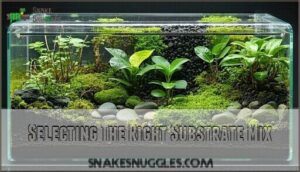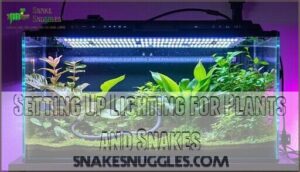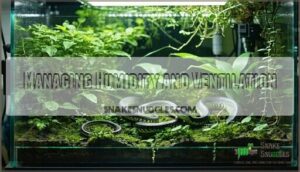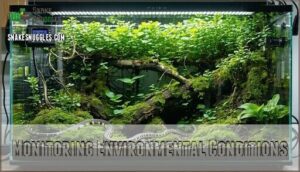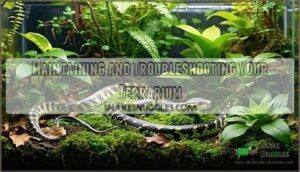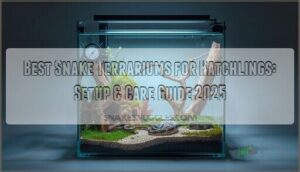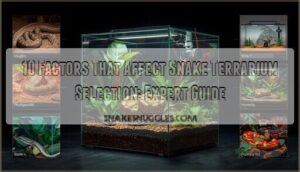This site is supported by our readers. We may earn a commission, at no cost to you, if you purchase through links.

Create a drainage layer using 2-3 inches of Leca clay balls, then add specialized substrate for your cleanup crew. Install heat mats with thermostats to maintain 85-88°F basking spots and 75-80°F cool zones.
Full-spectrum LED grow lights keep plants healthy while providing natural day cycles. Introduce springtails and isopods as your biological cleanup crew—they’ll handle waste naturally.
The magic happens when you balance temperature, humidity, and microfauna populations for a self-sustaining habitat.
Table Of Contents
- Key Takeaways
- Choosing The Best Snake and Terrarium Setup
- Building The Ideal Bioactive Environment
- Equipping for Temperature, Light, and Humidity
- Establishing a Self-Sustaining Ecosystem
- Maintaining and Troubleshooting Your Terrarium
- Frequently Asked Questions (FAQs)
- How do I set up a bioactive terrarium?
- Are bioactive terrariums good for snakes?
- What is in a snake terrarium kit?
- Which Terrarium is best for a corn snake?
- What do I need for a bioactive snake enclosure?
- Are bioactive tanks good for snakes?
- What is the best bioactive substrate for snakes?
- Are bioactive terrariums hard to maintain?
- How long does it take to establish a bioactive system?
- What insects are safe for a bioactive snake terrarium?
- Conclusion
Key Takeaways
- You’ll need proper foundation layers – start with 2-3 inches of Leca clay balls for drainage, add mesh separation, then mix bioactive substrate using 40% coco coir, 30% organic topsoil, and 30% sphagnum moss
- Choose beginner-friendly species like corn snakes or ball pythons that thrive in bioactive environments, and size your enclosure properly – 40-gallon minimum for ball pythons, 20-gallon long for corn snakes
- Install essential equipment including heat mats with thermostats (85-88°F basking, 75-80°F cool side), full-spectrum LED grow lights for plants, and humidity control systems to maintain 50-80% humidity levels
- Introduce springtails and isopods as your cleanup crew – they’ll naturally process waste and maintain the ecosystem, reducing your maintenance workload by about 75% once established after 4-8 weeks
Choosing The Best Snake and Terrarium Setup
Starting your bioactive snake terrarium begins with choosing the right snake species that matches your experience level and commitment.
You’ll need to match your snake’s natural habitat requirements with a properly sized enclosure to create a thriving ecosystem.
Selecting Suitable Snake Species
Choosing the right snake species sets the foundation for your bioactive success.
Beginner snakes like corn snakes and ball pythons offer docile temperaments, making handling stress-free.
Docile temperaments make corn snakes and ball pythons perfect beginner choices for stress-free handling
Size constraints matter—stick with species reaching 3-5 feet to avoid outgrowing your enclosure.
Consider dietary needs and feeding frequency, as this affects waste production your cleanup crew must handle.
Considering Bioactive Compatibility
Not every snake thrives in a bioactive terrarium environment.
Your species selection directly impacts microfauna balance and cleanup crew effectiveness. Burrowing snakes like hognose benefit from deeper bioactive substrate, while arboreal species need careful plant toxicity considerations.
Enclosure size affects how well springtails and isopods establish colonies. Match your snake’s natural behaviors with habitat mimicry requirements for ideal reptile health outcomes, considering the importance of microfauna balance.
Researching Natural Habitat Needs
Understanding your snake’s Species Biomes and Natural Behaviors transforms your bioactive terrarium from a simple snake enclosure into a thriving reptile habitat.
Research your species’ Geographical Range, Dietary Needs, and Conservation Status to replicate authentic conditions.
Forest dwellers need humidity and climbing branches, while desert species require arid substrates and temperature gradients that mirror their homeland.
Determining Proper Enclosure Size
Your snake’s adult dimensions dictate terrarium tank selection more than current size.
Most species need enclosures matching their full length and twice their width. Ball pythons require 40-gallon minimum tanks, while corn snakes thrive in 20-gallon long setups.
Consider activity levels and enrichment needs when choosing your reptile habitat. Future growth planning prevents costly bioactive terrarium upgrades later.
Proper ventilation is key to preventing humidity buildup.
Building The Ideal Bioactive Environment
Creating your bioactive snake terrarium starts with building the foundation layers that’ll keep your ecosystem thriving for years.
You’ll need to construct a proper drainage system and choose substrate materials that support both your snake’s natural behaviors and the beneficial organisms that make bioactive setups work.
Creating a Drainage Layer
With your terrarium setup chosen, you’ll need to build a solid foundation that prevents water from drowning your plants and breeding anaerobic bacteria. Think of your drainage layer as the terrarium’s plumbing system.
Here’s how to create effective terrarium drainage:
- Add Leca clay balls – Spread 2-3 inches of expanded clay pebbles as your base layer for superior water retention
- Install Biodrain Mesh – Place mesh separation between drainage and substrate to prevent soil mixing
- Use BioDrain Substrate – Layer specialized drainage materials that promote healthy water flow and root health
- Test water movement – Pour water through to confirm proper drainage before adding your substrate mix
- Check for waterlogging prevention – Verify no standing water remains after 24 hours to avoid harmful bacterial growth.
A vital aspect involves selecting a substrate that supports a thriving ecosystem.
Selecting The Right Substrate Mix
Picture your terrarium’s foundation as a recipe for success. The right bioactive substrate creates a living ecosystem that supports your snake’s natural behaviors.
Mix 40% coco coir with 30% organic topsoil and 30% sphagnum moss for ideal moisture levels and burrowing support. Add activated charcoal for toxin binding and aeration improvement.
Create your living ecosystem foundation with this proven soil recipe for thriving bioactive success
This tropical substrate composition feeds beneficial microorganisms while maintaining proper soil composition for plant growth. A blend of peat moss, play sand, and sphagnum moss can also be used to create a suitable substrate composition for a bioactive system that promotes healthy plant growth and supports your snake’s well-being with proper soil composition.
Designing Hardscape and Hiding Spots
With substrate in place, you’ll create the structural backbone that transforms your bioactive terrarium into a natural haven.
Smart hardscape placement provides security zones while supporting your snake’s behavioral needs.
- Rock placement creates thermal gradients and secure hiding spots beneath overhangs
- Branch selection offers climbing enrichment with sturdy, appropriately-sized natural wood
- Hiding variety includes multiple shelter options using caves, cork bark, and stacked stones
- Naturalistic design mimics wild habitats through strategic positioning of hardscape elements
Consider appropriate rock materials for safety.
Adding Live Plants and Mosses
With your hardscape foundation set, live plants bring the ecosystem to life.
Choose hardy terrarium plants like pothos or snake plants that tolerate high humidity.
Focus on plant toxicity—select non-toxic species since snakes occasionally nibble vegetation.
Rooted foliage creates natural hiding spots, while vertical plants offer climbing enrichment.
Native species maintain stable oxygen cycles.
Moss retains moisture and adds texture throughout your setup, creating a natural environment with stable oxygen cycles.
Equipping for Temperature, Light, and Humidity
Creating the right environment is essential for your snake’s health and your bioactive system’s success.
You’ll need to balance temperature, lighting, and humidity to match your snake’s natural habitat while keeping live plants and cleanup crew thriving, which is crucial for the overall success of your bioactive system.
Installing Heating Systems and Thermostats
Now that your bioactive foundation is solid, you’ll need proper heat to keep your snake healthy. Temperature regulation creates the perfect environment for both your reptile and the living ecosystem you’ve built.
Here’s what proper heating brings to your terrarium:
- Boosted immune system – consistent temps keep your snake’s defenses strong
- Better digestion – proper heat helps process food efficiently
- Active behavior – snakes move and explore more in ideal conditions
- Thriving cleanup crew – springtails and isopods work better with steady warmth
- Healthy plants – roots grow stronger in regulated soil temperatures
Install your heat mat under one end of the tank for heat mat placement. For ideal heating, consider the correct wattage options. Connect it to a thermostat for precise thermostat calibration.
Set basking spot temps between 85-88°F while keeping the cool side around 75-80°F. This temperature gradient lets your snake thermoregulate naturally. Always prioritize ceramic heater safety by securing equipment properly.
Setting Up Lighting for Plants and Snakes
Once you’ve got your heating dialed in, proper bioactive lighting becomes your next priority.
You’ll need dual-spectrum lighting that serves both your snake’s UVB requirements and supports robust plant growth in your bioactive terrarium.
Install full-spectrum LED grow lights (6400K-6500K) alongside UVB fixtures to create the perfect lighting spectrum for your setup’s diurnal rhythm needs.
Remember that UVB lights are insufficient for plant growth, so supplemental lighting is key.
Managing Humidity and Ventilation
Proper humidity control and ventilation create the perfect balance for your bioactive terrarium.
You’ll need airflow strategies that prevent stagnant air while maintaining 50-80% humidity levels.
Install ventilation types like mesh panels or slots to stop mold growth.
Adjust misting frequency based on humidity gradients throughout the enclosure, which supports healthy plant growth and prevents respiratory issues in snakes, by maintaining a balance that is crucial for the overall ecosystem, including bioactive terrarium.
Monitoring Environmental Conditions
Once humidity and ventilation work together, you’ll need consistent monitoring to keep your snake healthy.
Digital controllers track temperature and humidity with incredible precision, taking the guesswork out of terrarium management.
- Temperature Monitoring – Use digital thermometers in both warm and cool zones, checking readings twice daily
- Humidity Control – Install hygrometers to maintain 50-80% humidity levels for most snake species
- Lighting Schedules – Set timers for 8-10 hour photoperiods to support plant growth and natural rhythms
- Ventilation Needs – Monitor air quality through mesh panels, preventing mold while maintaining proper moisture levels
Establishing a Self-Sustaining Ecosystem
Now that you’ve created the perfect environment, it’s time to introduce the living components that’ll transform your terrarium into a self-sustaining ecosystem.
These tiny cleanup crews and beneficial microorganisms work together to process waste, maintain soil health, and create the natural balance your snake needs to thrive, which is essential for a self-sustaining environment.
Introducing Springtails and Isopods
Your terrarium’s ready for its cleanup crew.
Introduce springtails first by pouring their culture water directly onto moist substrate. Add isopods by hand, using one starter culture per 10-20 gallons.
These detritivores work together perfectly – springtails tackle mold while isopods break down waste.
Proper bug hydration and species diversity create thriving microfauna benefits for your bioactive terrarium’s long-term success.
Adding Biodegradable Materials and Fungi
Your bioactive terrarium needs organic matter to fuel the ecosystem. Add leaf litter from oak or maple trees for slow decomposition rates.
Cork bark and cholla wood provide structure while breaking down gradually. These materials feed your microfauna and encourage beneficial fungi growth.
Source pesticide-free materials to protect your detritivores and maintain healthy decomposition cycles.
Balancing Microfauna and Plant Life
How do you achieve harmony between your cleanup crew and live plants?
Start with a 3:1 ratio of springtails to isopods for ideal waste decomposition. Monitor plant growth weekly, as healthy foliage indicates proper nutrient cycling from microorganisms.
Ensuring proper temperature and humidity is vital for a thriving bioactive setup.
Your bioactive terrarium thrives when species symbiosis creates natural population control, maintaining ecosystem stability without intervention.
Providing a Clean Water Source
Fresh water is the lifeblood of your bioactive terrarium, supporting both your snake’s health and the entire ecosystem.
You’ll need to maintain proper water dish size and placement while following strict water change frequency guidelines.
- Crystal-clear hydration keeps your snake healthy and stress-free
- Clean water dishes prevent harmful bacteria that threaten reptile care
- Strategic water source placement creates natural drinking spots
- Regular water source type monitoring guarantees the best snake health
- Consistent terrarium maintenance supports your bioactive system’s success
Maintaining and Troubleshooting Your Terrarium
Once you’ve established your bioactive snake terrarium, you’ll need to perform regular maintenance to keep the ecosystem healthy and thriving.
Daily spot checks and monthly substrate adjustments will help you catch problems early and maintain the delicate balance that makes bioactive setups so effective.
Spot Checks and Substrate Maintenance
Daily vigilance keeps your bioactive terrarium thriving like a well-oiled machine.
Check for mold identification around water sources and humid corners every morning. Spot clean waste immediately to prevent pest control issues.
Monthly substrate turnover maintains healthy cleanup crew populations. Replace water changes every 48 hours to avoid bacterial buildup.
Add bug supplementation when isopods and springtails populations decline. Selecting reptile-safe substrates is essential for their well-being.
Maintaining a bioactive terrarium and ensuring daily vigilance are crucial for the health of the terrarium.
Watering, Misting, and Plant Care
Your bioactive terrarium thrives when you master the watering balance.
Mist plants every two to three days, checking soil moisture first.
Use distilled water to avoid mineral buildup that harms sensitive plants.
Maintain 60-70% humidity with automated systems or manual spraying.
Prune dead leaves weekly to prevent decay.
Monitor water quality regularly for ideal terrarium plant care and healthy growth.
Managing Pests and Mold Issues
Even the best-maintained bioactive setups can develop pest and mold problems that need quick action.
Identifying pests like fungus gnats early prevents major infestations that disrupt your terrarium’s balance.
Here are three key prevention strategies:
- Boost ventilation – Poor airflow creates the perfect storm for mold growth and pest breeding
- Maintain proper moisture levels – Overwatering turns your substrate into a pest paradise
- Use biological controls – Springtails naturally consume mold spores while beneficial nematodes target pest larvae
For treatment options, diatomaceous earth safely eliminates mites without harming your bioactive bugs or snake.
Adjusting for Seasonal and Species Changes
Throughout the year, your bioactive terrarium needs adjustments to keep pace with changing conditions and your snake’s natural rhythms.
| Season | Temperature Gradients | Seasonal Humidity |
|---|---|---|
| Spring | Increase by 2-3°F | Raise to 60-70% |
| Summer | Maintain peak temps | Keep steady 65-75% |
| Winter | Drop 5-8°F for Species Hibernation | Lower to 50-60% |
Adjust Lighting Schedules from 12 hours in summer to 8 hours in winter. Monitor Diet Adjustments as metabolism slows during cooler months. Your terrarium humidity control and terrarium temperature control systems should mirror these natural cycles for ideal snake care.
Frequently Asked Questions (FAQs)
How do I set up a bioactive terrarium?
Don’t put the cart before the horse—start with your drainage layer using BioDrain substrate and mesh.
Add tropical bioactive substrate, install heating and humidity controls, introduce springtails and isopods as cleanup crew.
Then plant suitable vegetation.
Are bioactive terrariums good for snakes?
Yes, bioactive terrariums are excellent for snakes.
They create self-sustaining ecosystems that reduce maintenance while providing natural enrichment.
The cleanup crew processes waste, live plants improve air quality, and naturalistic environments reduce stress by 50%.
What is in a snake terrarium kit?
Like a well-stocked toolbox for reptile care, snake terrarium kits include substrate, drainage materials, live plants, cleanup crew bugs, hardscape elements, heating equipment, and monitoring tools for creating naturalistic environments.
Which Terrarium is best for a corn snake?
You’ll want a 40-gallon long terrarium for your corn snake. This size gives them room to stretch out and thermoregulate properly. Choose one with good ventilation and secure latches.
What do I need for a bioactive snake enclosure?
You’ll need bioactive substrate with drainage layer, clean-up crew like springtails and isopods, live plants.
Proper heating and lighting, humidity control, hardscape elements, and monitoring equipment for temperature and humidity levels are also necessary, including a clean-up crew.
Are bioactive tanks good for snakes?
Bioactive setups reduce stress indicators by 50% in captive snakes. You’ll find they’re excellent because the clean-up crew handles 75% of waste, creating self-sustaining ecosystems that mimic natural habitats perfectly.
What is the best bioactive substrate for snakes?
The best substrate mixes coco coir, organic topsoil, and sphagnum moss—about 40%, 30%, and 30%.
This combo holds moisture, lets snakes burrow, and supports microfauna.
Toss in some activated charcoal for extra freshness.
Are bioactive terrariums hard to maintain?
You’ll find bioactive terrariums easier to maintain than you’d expect.
Cleanup crews like springtails and isopods handle most waste, but you’ll still need to spot-check, prune plants, and change water regularly for a healthy habitat.
How long does it take to establish a bioactive system?
You’ll wait about 4-8 weeks for your cleanup crew to settle in and start working their magic.
Microfauna populations need time to establish stable colonies and begin effectively processing waste materials, which is a complete concept that requires patience.
What insects are safe for a bioactive snake terrarium?
You’ll want springtails and isopods as your cleanup crew.
They eat mold and decompose organic matter, while isopods break down waste and aerate substrate.
Both are completely safe for snakes and essential for maintaining your terrarium’s ecosystem balance.
Conclusion
Building a successful bioactive snake terrarium setup isn’t as complicated as many believe.
You’ve learned the essential steps to create a thriving ecosystem that benefits both your snake and the environment.
Your bioactive snake terrarium setup will reward you with reduced maintenance, natural behaviors, and a stunning display.
Remember to monitor temperatures, maintain proper humidity, and trust your cleanup crew to handle waste naturally.
With patience and the right foundation, you’ll have created a self-sustaining habitat that mimics your snake’s natural home perfectly, providing a perfect environment for natural behaviors.


